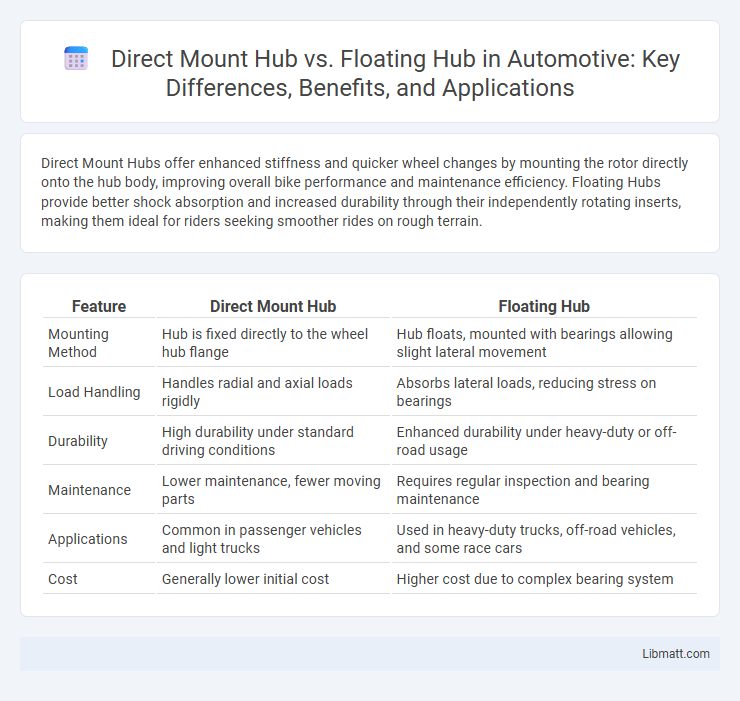Direct Mount Hubs offer enhanced stiffness and quicker wheel changes by mounting the rotor directly onto the hub body, improving overall bike performance and maintenance efficiency. Floating Hubs provide better shock absorption and increased durability through their independently rotating inserts, making them ideal for riders seeking smoother rides on rough terrain.
Table of Comparison
| Feature | Direct Mount Hub | Floating Hub |
|---|---|---|
| Mounting Method | Hub is fixed directly to the wheel hub flange | Hub floats, mounted with bearings allowing slight lateral movement |
| Load Handling | Handles radial and axial loads rigidly | Absorbs lateral loads, reducing stress on bearings |
| Durability | High durability under standard driving conditions | Enhanced durability under heavy-duty or off-road usage |
| Maintenance | Lower maintenance, fewer moving parts | Requires regular inspection and bearing maintenance |
| Applications | Common in passenger vehicles and light trucks | Used in heavy-duty trucks, off-road vehicles, and some race cars |
| Cost | Generally lower initial cost | Higher cost due to complex bearing system |
Introduction to Direct Mount Hub and Floating Hub
Direct Mount Hubs integrate the rotor directly onto the hub body, enhancing stiffness and reducing overall weight compared to traditional Floating Hubs, which use a separate carrier for the rotor. You will find Direct Mount Hubs favored in performance-oriented bicycles due to their easier maintenance and improved power transfer. Floating Hubs offer greater flexibility in rotor size and compatibility, making them a common choice for riders prioritizing versatility and customization.
Core Differences Between Direct Mount and Floating Hubs
Direct Mount hubs attach the rotor directly to the hub body, providing increased stiffness and reducing the number of parts, which enhances power transfer efficiency. Floating hubs feature a rotor mounted on a separate carrier that allows limited radial movement, improving heat dissipation and reducing rotor warping during intense braking. Your choice between these hubs impacts braking performance, maintenance complexity, and overall wheel durability in demanding riding conditions.
Design and Engineering of Direct Mount Hubs
Direct mount hubs feature a design where the rotor is mounted directly onto the hub shell, reducing the number of components and promoting increased stiffness and weight savings compared to floating hubs. This engineering approach enhances brake performance by providing a more rigid and stable connection, minimizing flex during braking. The simplified assembly and improved heat dissipation contribute to greater durability and reliability under demanding riding conditions.
Design and Engineering of Floating Hubs
Floating hubs feature a unique design where the hub shell is supported by separate bearings that allow lateral movement independent of the axle, reducing stress on the hub components and enhancing durability. This engineering innovation improves shock absorption and offers smoother power transfer by minimizing friction and wear in high-impact conditions. The floating design is particularly advantageous in downhill and enduro biking, where robust performance under extreme load is critical.
Performance Comparison: Direct Mount vs Floating Hub
Direct Mount Hubs offer superior stiffness and improved power transfer due to their larger flange diameter and fewer spokes, resulting in enhanced ride responsiveness compared to Floating Hubs. Floating Hubs provide better shock absorption and compliance, benefiting riders who prioritize comfort over maximum efficiency. Your choice between Direct Mount and Floating Hubs should align with whether performance or comfort is the primary goal for your cycling needs.
Pros and Cons of Direct Mount Hubs
Direct mount hubs offer increased stiffness and improved power transfer by reducing the number of interfaces between the hub and the rotor, making them a popular choice for mountain biking and downhill riding. Their main drawbacks include limited compatibility with certain rotor sizes and increased cost compared to floating hubs, as well as potential difficulties in hub servicing and maintenance. Your choice should balance the need for performance with considerations of repairability and bike setup flexibility.
Pros and Cons of Floating Hubs
Floating hubs offer increased adjustability and easier maintenance compared to direct mount hubs, allowing for quick wheel removal without affecting brake alignment. Their design reduces stress on axle bearings, leading to longer hub lifespan in rough riding conditions. However, floating hubs may sacrifice some stiffness and power transfer efficiency, making them less ideal for high-performance or competitive cycling.
Applications and Use Cases for Each Hub Type
Direct mount hubs excel in downhill and enduro mountain biking due to their robust design and superior stiffness, which enhances power transfer and handling on rough terrain. Floating hubs are preferred in freeride and trail riding for their ability to absorb shocks and reduce mechanical stress, improving durability and rider comfort. Each hub type caters to specific riding styles and conditions, optimizing bike performance for targeted applications.
Maintenance and Longevity Considerations
Direct mount hubs generally offer lower maintenance requirements due to their integrated design, which minimizes exposed parts and reduces dirt ingress. Floating hubs may require more frequent servicing as their components are more exposed to environmental elements, affecting longevity. Choosing a direct mount hub can enhance your bike's durability and decrease the time spent on upkeep.
Choosing the Right Hub: Direct Mount or Floating Hub?
Choosing between a direct mount hub and a floating hub depends on your bike type and riding style; direct mount hubs offer increased stiffness and better power transfer, ideal for downhill and aggressive trail riding, while floating hubs provide smoother pedal engagement and improved comfort, suited for cross-country or long-distance rides. Direct mount hubs integrate the rotor directly with the freehub body, reducing weight and enhancing braking performance, whereas floating hubs use a separate mount allowing for more flex and shock absorption. Consider terrain and riding intensity to select the hub that maximizes efficiency and durability for your specific cycling needs.
Direct Mount Hub vs Floating Hub Infographic

 libmatt.com
libmatt.com